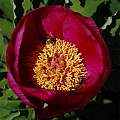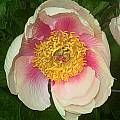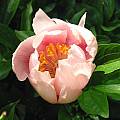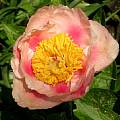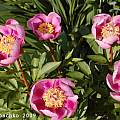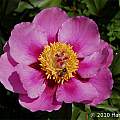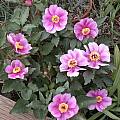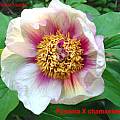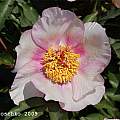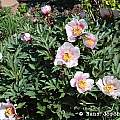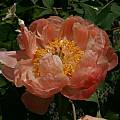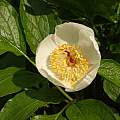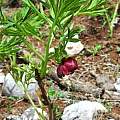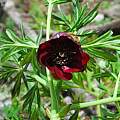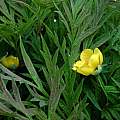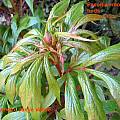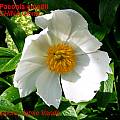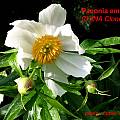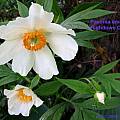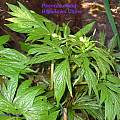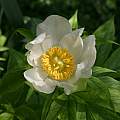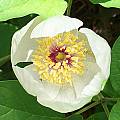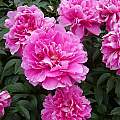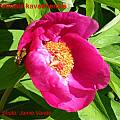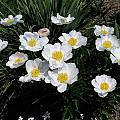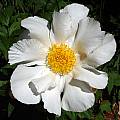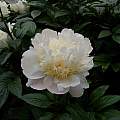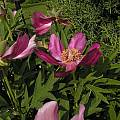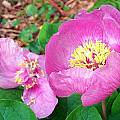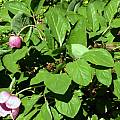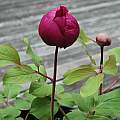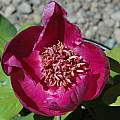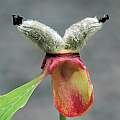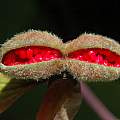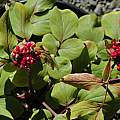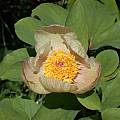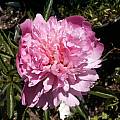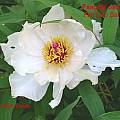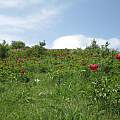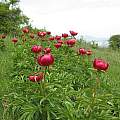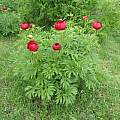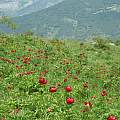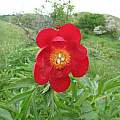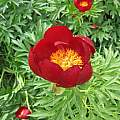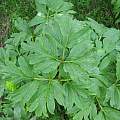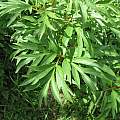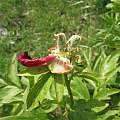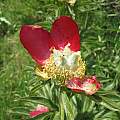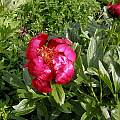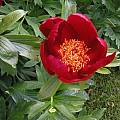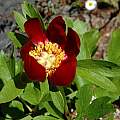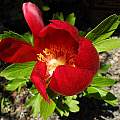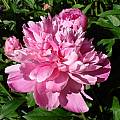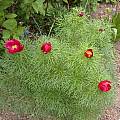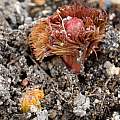Paeonia, the peonies, do not have bulbs, but because they spend their winter dormancy as large storage organs called rhizomes, they are often treated as geophytes, and the rhizomes are often sold along with bulbs in fall, when herbaceous peonies are divided and transplanted. There are both herbaceous and shrubby species, the latter known as "tree" peonies. The genus is widespread in the Northern Hemisphere, with centers of distribution in the northern Mediterranean rim, the Caucasus, and China, and one or two species in far western North America. Because hybridization is frequent in gardens, growing plants from seeds collected in the wild is the best guarantee of obtaining "true" species. Wild populations are variable. The most recent reference work on the genus is Josef Halda with James W. Waddick, "The Genus Paeonia" (Timber Press, 2004). Other references include W. T. Stearn and P. H. Davis, "Peonies of Greece: A Taxonomic and Historical Survey of the Genus Paeonia in Greece" (Goulandris Natural History Museum, 1984); and entries on the genus in "Flora Europaea" and "Flora of Turkey". Species peonies grown from seed do best when planted in light shade, particularly afternoon shade, since the young plants are liable to be damaged by too much sun; mature plants, however, tolerate full sun in temperate gardens. The seeds take a full year to germinate, with exposure to two cold periods. Seedlings can be transplanted to 6-inch pots in fall when the first leaves wither, then moved to the garden in one or two more years. Some older classifications include Paeonia in the Ranunculaceae family, but now this genus is usually placed in its own family, Paeoniaceae.
This genus was the subject of the Topic of the Week in July 2004. See Paeonia posts and Jim Waddick's Introduction-Part 1 Introduction-Part 2
Paeonia arietina G.Anderson syn. Paeonia mascula subsp. arietina (G.Anderson) Cullen & Heywood originates from Greece, Albania, and Turkey. It grows to 75 cm (30”) and has pink or magenta bowl-shaped flowers. It reportedly grows well in sun or part shade. Given ample water, the lobed green leaves will be green from spring into fall. Photo from Hans Joschko.
Paeonia 'Athena', an extra early blooming hybrid from Saunders, 1955 (P. lactiflora × (P. officinalis × (P. macrophylla × P. mlokosewitschii)). Similar in appearance to P. × chamaeleon, a natural hybrid, but is a bit shorter from my experience, earlier blooming, has glossy, mid-green leaves, rather than the bronze-green, matt, hirsute leaves of P. × chamaeleon . Athena's blossoms often open pink and fade to pale rose or white with the typical deep pink basal splashes. Very beautiful! Photos: Jamie Vande.
Paeonia broteroi Boiss. & Reut. is native to Spain and Portugal. It grows to 45 cm and has bowl-shaped pink flowers. Photos from Hans Joschko.
Paeonia cambessedesii (Willk.) Willk. is native to the Balearic Islands, where it is endangered owing to habitat loss. One of the smallest species in the genus and one of the least cold-hardy, it is distinguished not only by its beautiful pink flowers but also by its thick, metallic-lustrous foliage. The illustrated plant is growing in a bulb frame in Oregon, kept slightly moist in summer. Plants outdoors at this location survive but do not flourish, suggesting that winter temperatures below about 25 degrees F (minus 4 °C) are deleterious to their health. Height: to about 45 cm. Photo by Jane McGary
Paeonia × chamaeleon was validly published (Paeonia × chameleon Troitsky (1930) ex Grossg) and was defined there as a wild hybrid between Paeonia caucasica and Paeonia wittmanniana. However Plants of the World Online considers it to be a synonym for Paeonia daurica nothosubsp. lagodechiana. Others consider it to be a natural hybrid of Paeonia mlokosewitschii and Paeonia caucasica. And other information describes a Paeonia 'Chamaeleon' of unknown origin. The original text when this photo was added to the wiki was "Flowers in late spring and has beautiful, bronzy, hirsute foliage. Flowers variable from clone to clone." Photo: Jamie Vande
Paeonia clusii Stern is endemic to the Greek island of Crete. It grows in hills at around 1200 to 1500 m. It has pinkish-purple stems, glaucous dissected leaves, and usually white, but sometimes pink, flowers. This species blooms briefly in mid-spring. It requires extremely well drained soil and should be kept dry during the summer. It is quite hardy, but because it starts to grow quite early in the year in cold climates, foliage can be damaged by late frosts. Jim Waddick suggests this species could be grown best when planted against a south or west-facing wall or in a raised bed. Height range: 25-50 cm. Photos from Hans Joschko.
Paeonia 'Coral Charm', a hybrid introduced in 1964 by Samuel Wissing. Photo by Jim McKenney
Paeonia daurica Andrews is native to Europe and areas of temperate Asia. Some authorities list it as having 8 subspecies (including natural hybrids) and others do not recognize the subspecies and they are included in the species.
Paeonia daurica subsp. wittmanniana (Hartwiss ex Lindl.) D.Y.Hong is a robust early-flowering Caucasian peony with huge foliage, sometimes the first to bloom. Height range: 60-90 cm. Photographed by Jim McKenney in his USDA zone 7 Maryland garden where the fleeting flowers are always white and have never shown any trace of yellow.
Paeonia delavayi Franch. is a variable shrubby species, easily recognized by the 1-3 small, nodding flowers, situated below the leaves. The type form has deep burgundy color flowers. Plants with yellow flowers have been treated as separate species Paeonia lutea Delavay ex Franch. or as subspecies lutea (Delavay ex Franch.) B.A.Shen, but are now agreed to be part of a continuum, as intermediate orange forms have also been found and/or bred. P. delavayi has served as the female parent of the popular lutea hybrid tree peonies, as it flowers several weeks after the other parent, Paeonia × suffruticosa Andrews. Height range: 3-5 ft.
Growing in open situations, forest clearings, roadside, etc. In gardens, they may even turn into a thug, as they tend to spread aggressively via stolons. Photos of the type form were taken in northwest Yunnan by Oron Peri, pictures with yellow flowers show a plant cultivated by Martin Bohnet in southern Germany.
Paeonia emodi Royle is named after the Latin for Himalaya, Emodi Montes, whose western range is its home. Very early blooming, the foliage is often damaged by frosts in my Zone 8 garden. It forms a large (90-100 cm), lush plant of shiny, cut foliage, often tinged in red. Flowers are crisp white and appear from the axis as well as terminally. The Highdown clone, raised at the Royal Botanical Gardens, Edinburgh, Scotland is a very fine form with heavy floral substance. Recently, seedlings and collected material from China have appeared on the market. My plant is markedly red in foliage and the flowers less waxy, but tends to be more floriferous than the Highdown plant. It is also at least two weeks earlier in bloom. It should be noted that P. sterniana is similar, differing in bearing single flowers with 3-4 carpels. First five photos: Jamie Vande. Last photo taken on April 20, 2006, by Jim McKenney in his USDA zone 7 Maryland garden where it has grown for several decades. The small flowers bear a striking resemblance to those of white-flowered autumn anemones.
Paeonia japonica (Makino) Miyabe & H.Takeda in 2025 is considered to be a synonym of Paeonia obovata subsp. japonica (Makino) Halda or included in Paeonia obovata Maxim. This Asia temperate handsome plant is suited to open woodland. Height range: 40-50 cm. Photographed in the garden of Jim McKenney.
Paeonia 'Kashokunoten' (= wedding ceremony). Photo by Mari Kitama.
Paeonia kavachensis Azn. in 2025 is considered to be a synonym of Paeonia mascula. The colour of these blossom is so bright as to almost hurt your eyes. Photo: Jamie Vande.
Paeonia lactiflora 'Krinkled White' has early, single, white flowers and strong stems. Photos by Nestor White and Jay Yourch.
Paeonia 'Latin Doll'. Photo by Mari Kitama.
Paeonia mascula (L.) Mill. according to Wikipedia is native to China, Italy, Morocco, Spain, Greece and Turkey. It is a herbaceous perennial plant 0.5–1.5m tall with leaves that are divided into three segments and large red flowers in late spring and early summer. Photo #1 shows it growing in the previous garden of Pat and David Victor in England, blooming May 2004. Photo by Bob Rutemoeller. Photos 2-3 are two more views, this time from the garden of Jim McKenney where this species is typically the first to bloom each year. The plant in this view is not thirsty; this is what they do when the temperature gets up into the 80s °F. In our climate the blooms are fleeting.
Photos below show this species from bud to seed, grown by Mary Sue Ittner from seed. Plants I added to the garden did not return, but this one I kept in a container finally bloomed in 2010.
Paeonia mlokosewitschii Lomakin in 2025 is considered to be a synonym of Paeonia daurica ssp. mlokosewitschii (Lomakin) D.Y.Hong. It comes from the Caucasus, where it grows on rocky slopes and in oak/beech forest. It is well known in gardens for its early though short-lived yellow flowers; however, plants in cultivation under this name often turn out to be hybrids. The illustrated plant was grown from seed collected in Georgia by Josef and Jarmila Halda and is 5 years old, growing in a raised bed, shaded in the afternoon, in northwestern Oregon. The pink flush on the flowers is typical of this variable species. Photo by Jane McGary.
Paeonia 'Mons. Jule Elie' - This is a photo from a container grown plant in So. Cal. Photo by John Ingram.
Paeonia ostii T.Hong & J.X.Zhang was described in 1992. It is a species from the section Moutan, the tree Paeonies. It or a derived cultivar has been recently imported in large numbers to Europe, often offered under the name 'Fen Dan Bai', which is a generic cultivar raised for medicinal purposes in China. If this photo represents the true species is questionable, but other plants labeled as 'Fen Dan Bai' always had more ruffled flowers and less prominent flares, if any. Best considered a reference shot at this point. Early flowering and often damaged by frost. Mature stems silver-grey with peeling bark. Photo: Jamie Vande.
Paeonia peregrina Mill. is known to have a Balkanic distribution, and it also occurs as disjunct populations in some mountains in Southern Italy. Here a series of photos in habitat by Angelo Porcelli.
The species is rather homogeneous; I did not see any appreciable variation in flower colour while leaves can show more variability.
Most of the flowers usually bear 2 seedpods, but some individuals have 3 and even 4.
Photos 1-2 by Bob Rutemoeller of plants growing in Pat and David Victor's garden in England and blooming May 2004. The first was grown from seed collected in Bulgaria. Photos 3-4 were taken by Mary Sue Ittner of plants grown from seed from a friend and labeled var. romanica. No varieties or subspecies are accepted by The Plant List for this species and there are none listed in IPNI. It wasn't in bloom for a very long time, but beautiful while it lasted.
Paeonia 'Sarah Bernhardt' has early, fully double, rich pink flowers. Photo taken May 2007 by Jay Yourch.
Paeonia tenuifolia L. is native from southeastern Europe east to the Caucasus, on steppe and in open woodland. It is reported to grow best in gardens where winters are cold, with reliable snow cover. A double form is common in cultivation, though not always easy to maintain. The illustrated plant was grown from seed collected by J & J Halda in the western Caucasus, where Halda reports that plants are smaller in all their parts. It is shown growing in a raised bed with afternoon shade, in northwestern Oregon, where it does not experience the desired winter cold. The plants show a curious growth pattern, as every leaf and the flower bud are clearly visible when they first break trough the ground in March. Photos by Jane McGary and Martin Bohnet.
Paeonia wittmanniana Hartwiss ex Lindl. is a synonym for Paeonia daurica subsp. wittmanniana (Hartwiss ex Lindl.) D.Y.Hong.
